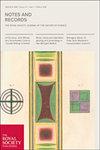地下收获:近代早期矿石争论中的再生理论和植物类比(一)
IF 0.6
3区 哲学
Q3 HISTORY & PHILOSOPHY OF SCIENCE
Notes and Records-The Royal Society Journal of the History of Science
Pub Date : 2023-09-13
DOI:10.1098/rsnr.2023.0032
引用次数: 0
摘要
现代早期使用植物术语来解释矿石的起源和生长,在采矿业、炼金术和自然哲学中广泛使用。在来自不同背景的作者的作品中,矿脉经常被描述为向上移动、结果、经历生命周期的“树”。因此,矿石中“种子”的存在(因此也就有了(再生)能力)经常被用来解释矿物和植物之间明显的相似性。这种描述矿物过程的方法——在这里被称为植物学模型——也对术语产生了持久的影响,矿工和科学家之间仍然常见的各种表达证明了这一点。这些术语背后的概念是对矿产资源的更大的“有机解释”的一部分,这些解释一直持续到18世纪,并对地球科学、采矿业和人与环境关系的发展做出了贡献。本文主要关注的是植物学模型在欧洲文艺复兴时期的兴起,这是一个更广泛的研究的第一部分(将在即将发表的论文中完成),研究这个重要概念的演变及其在整个现代早期与新科学的相互作用。本文章由计算机程序翻译,如有差异,请以英文原文为准。
Harvesting Underground: (re)generative theories and vegetal analogies in the early modern debate on mineral ores (I)
The early modern use of vegetal terms to explain the origin and growth of ores was widespread in mining industry, alchemy, and natural philosophy. In the writings of authors from many different backgrounds, mineral veins were often described as ‘trees’ which moved upwards, bore fruits, and underwent a life cycle. Accordingly, the existence in ores of ‘seeds’ (and, therefore, of a (re)generative power) was frequently invoked to explain the apparent similarities between minerals and plants. This method of describing mineral processes—called here the botanical model —also had a lasting terminological influence, as is attested by various expressions that are still common among miners and scientists. The notions underlying these terms are part of a larger body of ‘organic interpretations’ of mineral resources that endured into the eighteenth century and contributed to the development of the Earth sciences, mining industry, and the human–environment relationship. In focusing mainly on the rise of the botanical model in Renaissance Europe, this essay is the first part of a more extensive study (to be completed in a forthcoming paper) on the evolution of this important concept and its interaction with the new science throughout the early modern period.
求助全文
通过发布文献求助,成功后即可免费获取论文全文。
去求助
来源期刊
CiteScore
1.50
自引率
0.00%
发文量
45
审稿时长
>12 weeks
期刊介绍:
Notes and Records is an international journal which publishes original research in the history of science, technology and medicine.
In addition to publishing peer-reviewed research articles in all areas of the history of science, technology and medicine, Notes and Records welcomes other forms of contribution including: research notes elucidating recent archival discoveries (in the collections of the Royal Society and elsewhere); news of research projects and online and other resources of interest to historians; essay reviews, on material relating primarily to the history of the Royal Society; and recollections or autobiographical accounts written by Fellows and others recording important moments in science from the recent past.

 求助内容:
求助内容: 应助结果提醒方式:
应助结果提醒方式:


